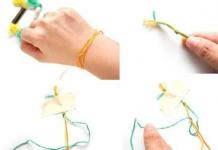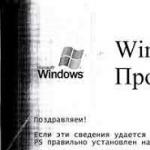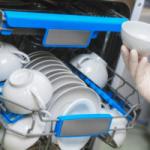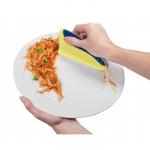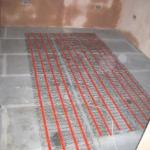Cold welding refers to those methods of joining parts that do not need heating. It should be understood that this type of connection is used only in cases where classical welding cannot be applied. The reasons include too large dimensions of the parts to be joined, or the presence of internal stresses. Often, cold welding, like classical welding, is used to connect metal objects. In both cases, there is a need for special equipment. During cold welding, mutual deformation of surfaces occurs, which must be cleaned before joining.
Features of cold welding
It should be noted that during cold welding a high-strength joint is created, which is not inferior in quality to many other methods of joining parts. Specialists actively use cold welding to join cadmium, zinc, silver, iron, aluminum, copper, lead and nickel. An important advantage of cold welding is the joining of dissimilar metals.
The parts are overlapped in this way. At this time, punches are pressed into the metal from different sides. Connection zones can be not only in the form of seams, but also in the form of points. Compression zones help to reduce vibrations of the parts to be welded. Also, this welding method can be used to join low-plastic materials.
There are also disadvantages of cold welding. Quite often, when connecting parts, additional pressures are created that occur on small surface areas.

Roller welding
Roll welding is one of the most popular methods of cold joining parts. It is used in various industries, but the most important thing to know about this welding method is its reliability. This is a truly versatile cold weld that creates a one-piece joint.
The principle of its operation is that two parts are located under the roller and carefully pressed against the surface. Next, the rotation of the rollers begins, which contributes to the insertion of the working projections of the parts. Thus, there is a slow movement of welding objects. In the end, one can observe a monolithic seam, which is much stronger than the seam of classical welding.
Obviously, there are negative aspects to this welding method. First of all, this is the free flow of metal along the entire seam line. In any case, you can choose a more massive roller that will solve this problem. Often this type of welding is used directly on metal-cutting machines, which is very convenient.
The question of the rationality of roller welding is very acute. Some experts do not advise its use in a single production. However, there is clearly a benefit to using roller joints for mass-produced products.
Use of glue paste
The method of cold welding, which consists in the use of glue-paste, is especially popular, many people know about it and actively use it. Every year the variety of the range of such products is growing, and the price is falling, which cannot but rejoice. At the same time, you should know in detail the technology for using glue-paste, otherwise there is a chance of running into trouble.
Use adhesive paste in cases where there is an aggressive environment that can damage a standard welding joint. Often, gas tanks, batteries, mufflers and other vehicle parts are repaired in this way. Often, glue paste is suitable for repairing aquariums, furniture, and water pipes. Accordingly, in all these cases it is practically impossible to apply classical welding, and it would be completely inefficient.
It is also important to note that this type of welding will help to connect small parts to each other, which are completely unsuitable for the classical method. Moreover, glue paste will help create a minimal seam, which can be almost invisible. Cold welding mastix is especially popular among the existing means for joining parts. This type of glue-paste is able to restore any fragments of metal products that operate at temperatures from -60 ºС to +150 ºС. Such opportunities are quite impressive, but there are also disadvantages. First of all, it is worth noting that the adhesive paste is not intended for joining massive objects. As already mentioned, it is desirable to use this type of cold welding to restore small fragments of parts. In other cases, only classical welding can be effective.
The main features of the use of cold welding
- Before starting the cold welding process, we will need to thoroughly clean the surface of the part from rust. It is recommended to use sandpaper for this. If possible, you can treat the surface of the parts with acetone (for degreasing), and then dry.
- We take the required volume of glue-paste and mix with our fingers until smooth.
- Now we need to apply the mixture to the part that we need to repair. In order for the paste to “grab”, you need to press and fix the restored area of \u200b\u200bthe part for 40 minutes. Sometimes it is recommended to apply the mixture to the surface with reciprocating movements, which will help ensure excellent adhesion of the composition. If the surface of the part is oily, then the strength of the connection is significantly reduced. A flat object is best for shaping and smoothing the surface. Often these kinds of tools come with glue-paste.
- The mixture can be formed within 20 minutes. After another 20 minutes, the composition will “grab”. After 1.5-2 hours, the repaired part can be used in work without limiting its load.
Safety of use
It is important to note that the components of the adhesive paste adversely affect human health. If the mixture gets on the skin or in the eyes, it is necessary to urgently consult a doctor who will take all necessary measures to prevent negative processes. It is advised to use rubber gloves and goggles, which will help to avoid all troubles. Especially serious should be taken to work with cold welding near places where food is located. So it is advisable to carry out any actions with glue-paste at special workplaces.
Comments:
Cold welding is a method of joining iron parts that excludes temperature effects.
Cold welding can be purchased at any car dealership.
Yes, this method will not make the parts newer, but it will extend the shelf life of the part while the owner is looking for options to replace it. This method of connection allows not only the gap in the tank, which began to leak, to be repaired, but also to replace all parts with new ones.
Cold welding for metal: characteristics and properties
The product for welding is a two-component material with plasticity. When the necessary components are mixed together, a chemical reaction occurs, leading to the hardening of the joints. Components are made using epoxy resins with iron additives.
The iron component is needed as a filler in welding. Additional additives are sulfur and other important elements. Bonding usually occurs based on the process of deformation of the plastic used for the connection, that is, its precise penetration into any surfaces.

During hardening, the seam becomes quite rigid, so it can withstand considerable loads. Technical handbooks contain examples of how the application of the process causes the restoration of components and parts of even heavy vehicles, the service life of which has been extended to 50 thousand km. regarding engines.
Cold welding is a relatively new type of connection by gluing. Before starting work, the instructions for cold welding for metal should be carefully studied. This method is most suitable for non-ferrous and ferrous types of metal.
The method of cold welding seals, glues, repairs any products. You can sometimes engage in the restoration of missing pieces. It is possible to use it in the temperature range from -60°C to + 150°C, when welding is carried out in rooms with a high level of air humidity.
Back to index

Before using the cold joining method, it is necessary to prepare the necessary surface, which is cleaned by sanding. If there is a coating based on paints and varnishes, they must be removed, and if corrosion is present, it should be treated. Then you need to degrease the required surface, you can, for example, use acetone.
The set used to make the connection assumes the presence of two rods made of a substance that resembles plasticine. The components are combined, and after half an hour the whole composition becomes solid. Combine the mixture by hand, kneading it, as is the case with plasticine.
The composition of cold welding is sometimes applied manually, sometimes spatulas are used, which are moistened with water before starting work. Each part must be in a stationary state for about half an hour after repair. Final hardening may occur after a day.
When working, simple safety measures are required:
- Use gloves.
- Do not use materials that react with welding products.
- Rinse the skin if the welding product gets on the skin, and then immediately seek medical help.

Cold welding must be kneaded in the hands before use.
You can wash off the composition from your hands with a soapy substance. The set of products for welding should be stored in a dry and dark room at a temperature not exceeding 35°C. After the product used has dried, it is softened in heat.
Cold welding is a special polymer that has the quality of sticking together when the surface is heated. The strength of the polymer depends entirely on the components, on the correct penetration of the adhesive into the surfaces and their preparation. Classic welding with a welding machine allows you to make a stronger connection that lasts much longer than after cold welding. That's why
it should only be used to repair various small parts.
Back to index
Using Welding to Repair Polypropylene Pipes
Joints in polypropylene pipes should not leak, so it is recommended to use a high-quality welding machine in the future to process polypropylene pipes. It will allow to carry out work in accordance with the technology. The temperature that is maintained by cold welding depends on the composition and characteristics indicated on the package.
With strict observance of all instructions, the seam will retain its strength. It should be realized that the greatest strength can only be achieved with a more precise application of cold welding. Therefore, the compositions with the highest temperature are used in the repair of parts operated in normal temperature conditions.
The adhesive composition used in cold welding is used to connect all surfaces that are heated to very high temperatures, when the possibility of using classical welding is problematic. The mixture can be stored up to 3 minutes in working condition. Therefore, the glue should be applied on time.
When gluing two surfaces, they must be firmly fixed using a clamp. The required time indicated in the instructions must pass, after which the composition becomes solid. After repair, the surface can be puttied and painted over. The drying time of the composition can be from 1 to 8 hours. The instructions should indicate the method of using cold welding, its brand. All manufacturer's advice should not be violated, because otherwise the strength of the seams will be the least.
Back to index
In most cases, cold welding is used to repair cars and heating appliances. In each case, the use of this method has its own nuances, since, for example, repairing a car gas tank allows you to extend the shelf life, which eliminates the expense of large funds for new parts.
Before work, good access to the warped areas of the surface is necessary. There is a common way to alleviate this problem for yourself if there is a small hole: use a screwdriver to bring it to a rounded shape, then use a screw bolt that fits in diameter so that you can strengthen it with cold welding.
The cold welding method used for radiators is one of the popular methods for the use of these compositions by motorists. You can find exactly where the radiator is damaged by immersing it under water, and blowing it out with a compressor. The places where many bubbles that come to the surface from the water are the places of damage.
The cold welding method will be only a one-time option - the radiator usually does not withstand long-term use. With it, you can brew a silencer. It depends on the temperature level that the composition can withstand.
Be sure to use the high temperature modification before starting to bond the surface. This is due to the preliminary cleaning and preparation of the part. For example, the service life of a repaired muffler will be longer.
It is a composition designed to connect parts without the use of temperature effects. Gluing is carried out due to the plastic deformation of the mass and its penetration into the surface. This method has found its wide distribution in the field of plumbing and car repair. The mixture has many advantages, including, for example, the absence of the need for preparation.
Description
Glue cold welding can be one-component or two-component. The composition may include metal components and additional substances. In the first case, we are talking about the ingredients that are necessary to create uniformity and plasticity. If the composition includes metal ingredients, then they act as a filler. While the additional substance is sulfur, etc.
Glue "cold welding" is a mixture with polymeric ingredients. Strength will depend on the quality of the mixture, surface preparation and correct use. You should try to create ideal conditions under which the junction should be stronger than the base material, but in practice this is not always possible. Therefore, the described adhesive is used only for minor repairs.
Temperature characteristics

Quite often, the consumer has a question about what temperature level the adhesive composition will be able to withstand. On the packaging you can find certain parameters, under which the composition will remain strong. The maximum possible temperature for low-cost mixtures is usually 260°C or more.
However, it must be remembered that the mixture will be strong only if it is used correctly. This indicates that an adhesive with a low maximum temperature should be used to repair elements that will be used under normal conditions.
On the market, you will find an adhesive that will be able to withstand higher temperatures, it is called high temperature cold welding. Such mixtures will retain their characteristics at temperatures up to 1316°C. These compositions are suitable for connecting surfaces that are constantly exposed to heat, because the use of traditional welding is sometimes difficult.
Varieties of cold welding

If you need "cold welding" glue, then you should ask which manufacturer supplies the product to the market. Domestic products are usually more affordable, but not as high quality. Therefore, experts recommend, if possible, to purchase formulations from foreign manufacturers, including ABRO or Hi-Gear. The products of domestic manufacturers "Almaz" and "Polymet" have proven themselves well.
According to the composition of the adhesive and its consistency, liquid and plasticine-like varieties of cold welding should be distinguished. The first type are two-component compositions, the mass of which must be mixed before use. Plasticine-like in appearance is almost no different from ordinary plasticine. They have the form of a single-layer or two-layer bar. In the latter case, the mass is mixed before use.
There is also universal “cold welding” glue on sale, it is intended for metal, car repair, and the first variety can be used to work with metal, wood and polymers. These compounds are the most durable. If you purchase a mixture for metal, then it will have a metal filling and will do an excellent job of welding most metals.
If you have to work in difficult conditions, then you should choose the appropriate composition, for example, one that is designed for welding under water. The temperature regime at which the seam will be able to maintain strength is also important. The higher the maximum temperature, the stronger the composition under any operating conditions.
Description and properties of the epoxy composition

On the market, you can also find epoxy “cold welding” glue-plasticine. It is used to repair metals and their alloys. The composition is two-component and contains a hardener for epoxy resin. The composition is resistant to moisture, solvents and oils and does not change characteristics over time.
The glued products can be used at temperatures ranging from -40 to +150°C. Cold welding "epoxy glue" is simply mixed by hand, and the components are already selected in the right dosage. Plasticine after acquisition is completely ready for use. The mixture will remain viable for 5 minutes, therefore, after mixing, the composition can be applied and the position of the parts can be adjusted. After an hour, the glued products can be machined, namely, stripped, turned and drilled.
Description and properties of cold welding "Diamond"

Glue cold welding "Diamond" hardens within an hour after application. The mixture will reach its final strength in a day, after which the product can be subjected to structural loads. For reuse, the remaining adhesive can be wrapped in foil and packed in a tube.
You can work with the mixture even when the surfaces to be glued have high humidity. In this case, the composition should be smoothed until you feel adhesion to the surface. Prior to curing, the adhesive must be held with a tourniquet for 20 minutes. If it is necessary to accelerate the hardening process, the composition must be heated, for this you can use a household hair dryer. Work must be carried out in a well-ventilated area, the master should wear gloves. The adhesive contains:
- epoxy resins;
- mineral fillers;
- hardeners;
- iron fillers.
The tear strength is 120 kgf/cm², while the fracture temperature is 150°C. Brinell hardness is 120 kgf/cm². The viability of the mixture protects for 10 minutes, which is true at temperatures ranging from 20 to 30 ° C. Work should be carried out at a temperature not lower than +5°C.
Cold welding for linoleum

Glue "cold welding" for linoleum is commercially available in three varieties:
- glue type A;
- glue type C;
- glue type T.
The latter is rarely used. Type A glue has a liquid consistency, as it has a high solvent content. This structure allows the edges to dissolve for efficient bonding. It will not be possible to fill large gaps with this composition, because it is quite liquid.
The main advantage is the possibility of obtaining neat and almost imperceptible seams. Type A cold weld adhesive is great for new linoleum. If you cut the coating at home, then the edges of the canvases may turn out to be not quite neat. In this case, it is better to purchase type C glue.
Description and properties of adhesive type C

This adhesive contains more PVC and less solvent. The mixture is richer and thicker, so it can be used to fill even large gaps and cracks. Such a mixture is ideal for repairing old linoleum. When using this mixture, there is no need to adjust the edges of the sheets at all, gaps up to 4 mm wide are permissible. After drying, a strong and neat seam is formed, which will be difficult to notice.
Description of Type T Cold Weld Adhesive
This glue is cold welding for linoleum, which is used quite rarely. The composition is suitable for connecting multicomponent linoleums based on PVC and polyester. Using this type of welding allows you to achieve a reliable, neat and elastic seam. The composition is suitable even for gluing semi-commercial linoleum.
Features of the use of cold welding for metal "Thermo"
The above-mentioned adhesive is cold welding for metal, it is a metal-silicate composition of increased viscosity. The formula of the mixture ensures the elimination of defects such as shells, cracks and chips. You can use glue on metal parts made of cast iron, steel, titanium and others.
The mixture is effective in repairing burned-out muffler fragments and cracks without dismantling. After drying, the seam acquires high strength and water resistance, undergoes vibrations and the parts can be used at temperatures ranging from -60 to +900 ° C.
Before use, repaired parts must be cleaned of scale, rust and dirt, the base must be degreased with acetone or any other similar composition, and traces of oil must be removed. The composition should be mixed until a homogeneous consistency is formed, and then applied to the surface in an even layer using a spatula.
Conclusion
One of the main advantages of cold welding is the absence of the need for special training. The master does not have to have any skills; to achieve a positive result, it will be enough just to follow the attached instructions.
Many people have heard of such a concept as "cold welding", but not everyone has come across it in practice. This is a relatively new substance that allows you to fasten almost any material together. This includes not only metals, but also other substances. When using, the question may arise what temperature cold welding can withstand. After all, many metal parts are exposed to temperature effects, which can affect the quality of the seam connection and its properties. There is no definite answer here, since it all depends on the brand and composition of the material.
A distinctive feature is the ease of use, since despite the fact that it is inferior to standard welding in terms of strength and reliability, the characteristics obtained are quite sufficient for the purposes for which it is used. Areas of use are plumbing, car repair, industry and domestic work. The main operations include sealing cracks and holes, gluing parts, building up the surface of the material, and so on. The quality of the setting also depends on how you work with cold welding, since the preparatory processes have a big impact.
Types of cold welding
There are several varieties that differ not only in parameters, such as what maximum temperature cold welding can withstand, but also in appearance. The main types should be distinguished:
- Liquid composition - as a rule, consists of two components, which should be thoroughly mixed into one homogeneous mass immediately before starting work;
- Plasticine-like substance - presented in the form of bars, which consist of one or more layers, which also requires mixing before direct use;
- Universal composition that can be used as an adhesive for PVC, wood, metal and other things;
- Masses with the addition of a metal component that enhances strength and gives other additional properties;
- Materials that are created specifically for working with road transport;
- Substances for work under water.
Compound
Certain properties of the material, such as what temperature cold welding can withstand for metal, are determined by its composition. In substances that are used for metals, the following composition is found:
- A metal component that is a reinforcing filler and creates greater strength and reliability of the material itself;
- Epoxy resin is the main binding component used for gluing parts and ensuring the plasticity of the entire substance;
- Various additives, such as sulfur and others, which bring additional properties required for a particular brand.
For metal, it is precisely such cold welding that is used, the operating temperature of which, as a rule, is higher than that of the others. For example, the one used for linoleum has a slightly different composition:
- plasticizers;
- PVC;
- Tetrahydrofuran.
Due to this composition, some melting of the edges of the material occurs with the help of liquid welding itself. When in contact with various substances, it behaves differently, which is its peculiarity.
terms of Use
To determine the conditions, you should know what temperature cold welding holds. The main danger for the composition is the first hours, when it has not yet frozen. Then any operation is not recommended at all. During the first three hours, it is better not to touch the part at all. After a day has passed, it can be used in the same conditions in which it was used before. Temperature exposure limits are usually indicated on the packaging and will be different for each brand. In any case, in order for them to match what is written, you should strictly follow the installation instructions.
Specifications
Here are brief characteristics of how many degrees cold welding of one kind or another can withstand.
The use of any composition of cold welding begins with preparatory procedures. To do this, it is required to clean the surface of possible deposits of fats, dirt, oils and other excess substances. Metals are cleaned of rust in order to get to the very surface with which it will be bonded. After the surface is ready, you can begin to prepare the cold welding itself.

It is required to remove the components and mix them until such a state that a homogeneous mass is obtained. Solid stone blocks, as well as liquid two-component ones, must come to a state of plasticity, when various forms can be molded from them, like from plasticine. All work must be done with gloves so that there is no contact of the material with the skin. As soon as the material has taken the desired consistency, it should immediately be used. It is necessary to ensure that the layer of the applied substance is no more than 6 mm. If a greater thickness is required, then a second layer should be applied, but after the first one has dried. After everything hardens, the parts can be used for their intended purpose, without fear for the quality of welding, if the temperature regime has been correctly selected.
Cold welding for metal is a special plastic composition for joining metal products without conventional (hot) welding, which is not always applicable.
The bonding process occurs due to the interpenetration of the mass of the composition and the surfaces to be bonded. Cold welding is convenient to use, it does not require special tools and any equipment.
In contact with
This type of fastening in its action is pressure welding, and a continuous welding seam occurs during penetrating plastic deformation, which initiates the destruction of the oxide film on the joined planes, and brings the distance between them closer to the size of the crystal lattice. The concentration of the energy interaction of atoms on the planes being welded contributes to establishment of chemical bonds.
Cold welding for metal - the instruction allows you to glue products from any metal A: silver and copper, iron and lead, zinc and aluminum. This method is a good solution for the repair of metal parts that are sensitive to heat treatment. With its help, you can weld different metals: case aluminum wires with copper bushings.
Advantages of cold welding:

Composition and properties
Cold welding is inherently an adhesive for metals. The composition includes:
- adhesive - epoxy resins, due to which the plasticity of the composition and its uniformity are ensured;
- filler - metal powder;
- activating additives (sulfur).
The strength of the weld depends on the consistency of the composition of the adhesive with the types of metals being welded, on the quality of the preparation of the surfaces to be glued and its competent application. Under optimal conditions, the strength of the seam reaches the strength of the metal, but in practice, no matter how much you fight, it is almost impossible to achieve ideal conditions, respectively, and the strength of the seam will be significantly lower than in hot welding. For this reason, it can only be used for minor repairs and welding of parts that do not carry a large load.
 The temperature limit of resistance of the seam depends on the composition of the adhesive. This indicator can be found on the packaging and, subject to the gluing technology, the seam will be strong within the specified temperature value.
The temperature limit of resistance of the seam depends on the composition of the adhesive. This indicator can be found on the packaging and, subject to the gluing technology, the seam will be strong within the specified temperature value.
For inexpensive compositions, the temperature limit is set at 260 degrees. Special formulations adhesives allow the weld to not lose its strength at a temperature of about 1300 degrees. These compositions are used where products operate at high temperatures, and in situations where traditional welding is not possible.
Types of cold welding
The distribution network offers Russian-made cold welding at low prices and expensive imported ones. Depending on the position of the seam and the parts to be welded, the following types of cold welding are distinguished:
- for fastening tires or linings to wires made of copper and aluminum, handles to aluminum utensils - spot;
- for the manufacture of dust and moisture-proof housings and devices for various purposes and thin-walled containers - seam, which is produced using contour punches;
- when connecting wires and making rings - butt;
- fastening of brass studs to the terminals of aluminum transformer windings, manufacturing of angle and tee busbars for electric locomotives - tee;
- connection of water and heating pipes, transitional elements in railway power lines - shear welding.
According to the consistency and readiness for use, cold welding is made:
- fluid two-component. In this case, the resin is mixed with a hardener before being applied to the surfaces to be bonded;
- in the form of a plasticine mass- a bar or an elongated cylinder, consisting of one or two layers of reagents. Before work, pinching off the required amount of mass, it must be kneaded with your fingers, like plasticine.
In the direction of use, the following types are offered:

Operating procedure
How to use cold welding? To work with it, you do not need to be qualified and special equipment and accessories. Cold welding for metal - instructions for use will help everyone cope with the work. To bond metals, in addition to welding glue, you will need:
- abrasive for cleaning surfaces - emery cloth or sanding paper;
- surface degreasers - acetone, alcohol, any technical solvent;
- if necessary, a clamp or clamps, a vice.
Sequence of operations:

Some Applications
It is often used during heating system repairs and vehicle components. For example, you cannot repair a gas tank in the traditional way, but you can by cold welding, and thereby save money on buying a new tank. Repair of car radiators is another frequently used direction. To detect leaks in the radiator, it is placed in water and blown with compressed air - air bubbles will go through the leaks. Such repairs are used as a temporary measure, the radiator does not withstand long-term operation. The muffler of a car can also be patched with welding glue with a temperature limit of 260 degrees.
This method can also be used for temporary repairs. intra-apartment communications: pipelines for heating and water supply, sewerage, including PVC pipes. In this case, the welding adhesive must be waterproof. Piping damage should be minor. In the future, it is better to repair with traditional welding.
 Cold welding is not applicable if the load on the parts is significant, the weld does not work well for separation. Do not use glue intended for gluing metals in gluing wood, if the glue has a filler - metal powder, then it will not glue wood. When choosing a weld, look at application temperature limit– high-temperature cold welding is stronger than other similar ones. In the manufacture of glass cutters, a diamond can be attached to the handle with such an adhesive.
Cold welding is not applicable if the load on the parts is significant, the weld does not work well for separation. Do not use glue intended for gluing metals in gluing wood, if the glue has a filler - metal powder, then it will not glue wood. When choosing a weld, look at application temperature limit– high-temperature cold welding is stronger than other similar ones. In the manufacture of glass cutters, a diamond can be attached to the handle with such an adhesive.
